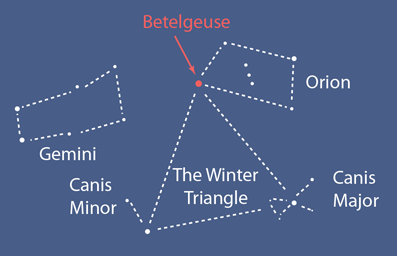Red Supergiants
A star of 15 solar masses exhausts its hydrogen in about one-thousandth the lifetime of our sun. It proceeds through the red giant phase, but when it reaches the triple-alpha process of nuclear fusion, it continues to burn for a time and expands to an even larger volume. The much brighter, but still reddened star is called a red supergiant. Betelgeuse, at the shoulder of Orion, is the best-known example. Absolute luminosities may reach -10 magnitude compared to +5 for our sun.
Some of these supergiants are unstable and form the very important Cepheid variables. In their final stages, supergiants may explode into supernovae. The collapse of these massive stars may produce a neutron star or a black hole. |
 |
Reference
Star diagram
Pasachoff
Ch 8
| HyperPhysics***** Astrophysics | R Nave |
